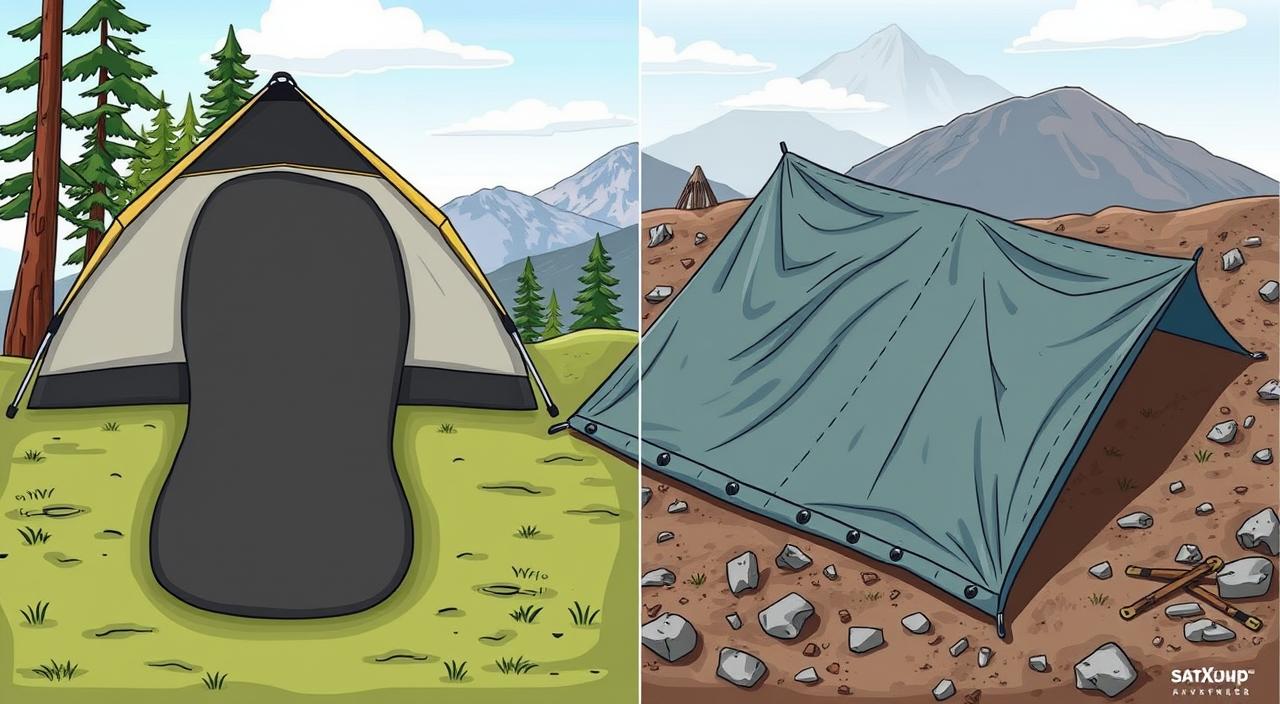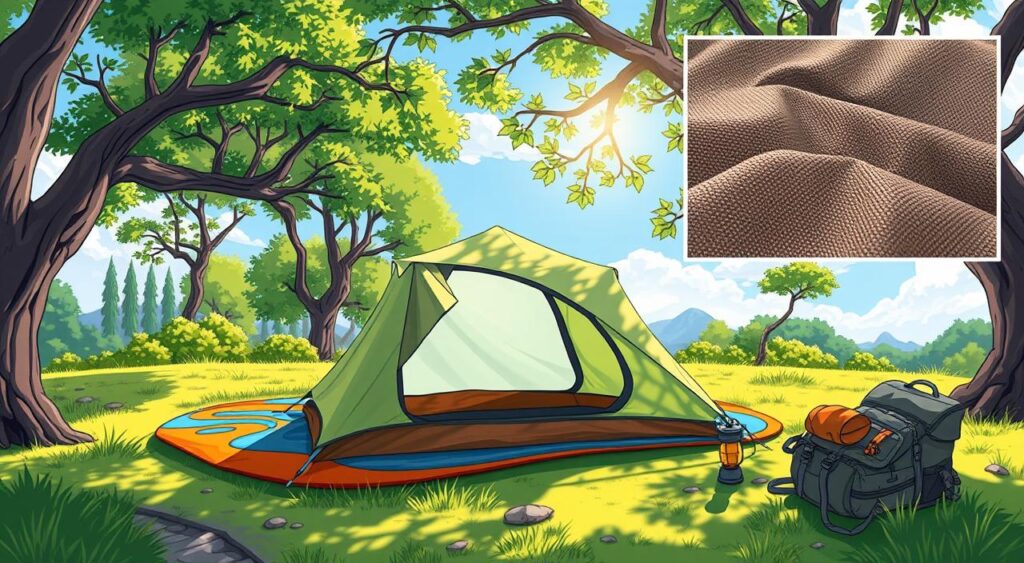
Disclaimer: This post may contain affiliate links. As an Amazon Associate, we earn from qualifying purchases.
Are you choosing the right gear for your outdoor trips? The choice between a tent footprint vs tarp can greatly affect your comfort and how long your gear lasts. Knowing the differences between these two can make your outdoor adventures better. Whether you need to keep your tent dry or find a good ground cloth, picking the right one is key.
Key Takeaways
- Tent footprints extend the lifespan of your tent by providing crucial protection against abrasions and moisture.
- The tent tarp footprint acts as a protective barrier against sharp objects on rough terrains.
- Moisture protection is vital when camping in damp conditions—don’t overlook this when choosing your gear.
- Always consider the material and size of your tent footprint for optimal performance.
- Essential camping gear comparison reveals that both options have their unique benefits in different situations.
- Tarps offer a lightweight, versatile solution beyond just ground cover.
- Your choice should reflect the terrain and weather conditions you’ll encounter on your adventure.
Understanding Tent Footprints
A tent footprint is key to your outdoor setup, acting as a shield under your shelter. It protects the tent’s floor from damage, punctures, and moisture. For those who love lightweight backpacking, picking the right tent floor protection is crucial to keep your gear safe.
Tent footprints are made from waterproof materials and are a bit smaller than your tent. This size helps prevent water from gathering under the tent, which can cause leaks. A custom-fit footprint for your tent model greatly lowers the chance of water getting in, giving you a dry and comfortable night’s sleep.
There are many options for tent footprints. You can buy one from your tent’s maker or check out outdoor stores like REI for a variety of choices. For a budget-friendly option, consider using materials like Tyvek housewrap.
Getting a tent footprint makes camping better and helps your tent last longer. Thicker materials like polyethylene are great for rough ground, while nylon taffeta is better for soft surfaces. These materials reduce the friction between the tent and the ground, which means less wear and tear. In the cold, a footprint can also keep heat in, making nights more comfortable.
| Type of Tent Footprint | Material | Best For | Benefits |
|---|---|---|---|
| Custom-Fit | Polyethylene | All terrain types | Optimal protection, prevents water pooling |
| Universal | Nylon Taffeta | Softer surfaces | Flexible fit, decent protection |
| DIY Tarp | Tyvek or similar | Budget use | Cost-effective, customizable size |
Whether you’re going on a long hike or a weekend camping trip, a tent footprint is a must-have. It keeps your gear safe and adds comfort, making your outdoor adventures more enjoyable.
What is a Tarp?
A tarp is a big sheet made from strong, flexible, and water-resistant material. It’s often used as a waterproof ground cover. These tools are key for outdoor adventures, offering shelter from the weather and many other uses. You can set up a tarp above your tent to keep out the rain or use it for shade on sunny days.
There are many sizes and materials for tarps, meeting various needs. They can be used as emergency shelters, picnic blankets, or even to collect rainwater. Because tarps are light, they’re easy to carry with your hiking or camping gear. This lets you bring more important items along.
With the right care, a tarp can make your outdoor trips better. It can give you a dry place to sit or protect your gear from the elements. Learning about the different tarp uses changes how you plan your adventures.

Benefits of Using a Tent Footprint
When planning your next camping trip, think about the tent footprint benefits. A tent footprint is key for your gear’s longevity and comfort. It protects against damage and improves insulation, making your trip better.
Protection from Abrasions and Punctures
A tent footprint acts as a shield between your tent and the ground. It stops rough ground like sharp stones and sticks from damaging your tent. This simple piece can make your tent last longer. Ground sheet advantages include keeping your tent safe from harmful ground conditions that could cause tears or leaks.
Moisture Barrier for Enhanced Comfort
Using a tent footprint also creates a moisture barrier. This stops water from getting through the tent floor, keeping you dry in damp places. Staying dry is key for a comfortable camping trip, making this feature vital.
Insulation from Cold Ground
A tent footprint adds insulation, keeping you warm by lifting you off the cold ground. This helps you stay warm, especially on cool nights. It lets you sleep better under the stars.

Advantages of Tarps as Ground Cover
Using a tarp as ground cover can make your camping trips better. It helps you pack lighter and smarter. Tarps are flexible and can be used in many ways during your outdoor adventures.
Lightweight and Versatile
Tarps are very light, making them great for hiking or backpacking. They let you carry what you need without adding a lot of weight. You can use them for many things, like keeping the ground dry, as a shelter from rain, or even to collect rainwater.
Cost-Effective and Multi-Purpose
Tarps are cheaper than tent footprints but do more. They fit many tents and can be used for camping, picnics, or DIY projects. This makes them a smart choice for anyone on a budget.
Easy to Set Up and Take Down
Setting up your campsite with a tarp is easy. You can adjust it for the weather or your needs quickly. This saves time and reduces stress, making tarps a great option for flexible camping.

| Feature | Tarp | Tent Footprint |
|---|---|---|
| Weight | Lightweight | Lightweight, yet generally heavier |
| Cost | Cost-effective | More expensive |
| Versatility | Multi-purpose uses | Primarily for tent protection |
| Setup | Easy to set up and take down | Custom fit makes setup straightforward |
In summary, tarps are a great choice for camping. They are lightweight, affordable, and versatile. They support many camping activities and keep you ready for anything.
Tent Footprint vs Tarp: Key Differences
Choosing between a tent footprint and a tarp depends on their unique roles. Tent footprints fit each tent perfectly, protecting it from damage. They make camping more comfortable and easier to set up, making them essential for serious campers.
Tent footprints cost between $40 and $90, based on size and material. This price shows they are designed to make your tent last longer. Tarps are cheaper and versatile, great for making shelters or protecting gear. But, they can be tricky to fit under a tent.
Comparing ground covers shows footprints are better at protecting against abrasion and providing comfort. Tarps might not fit well and can let water collect under the tent. On the other hand, footprints keep the tent’s bottom clean, shielding it from rocks and thorns.
| Feature | Tent Footprint | Tarp |
|---|---|---|
| Cost | $40 – $90 | Generally Lower |
| Fit | Custom to Tent Size | Requires Modifications |
| Water Resistance | Not Primarily Designed for It | Thick, Water-Resistant |
| Protection | Wear and Tear | Adaptable Coverage |
| Installation Ease | Quick Setup | Time-Consuming |
Knowing these differences helps in choosing the right tent accessory choices. Tent footprints are great for places where durability and a perfect fit matter. Tarps are better for various tasks. Each has its spot in camping gear, suited for different needs.
Choosing the Right Gear for Your Adventure
Choosing the right gear can make your camping trip better. It’s important to know when to use a tent footprint or a tarp. Each has its own benefits, making the right gear selection for camping key to fun.
When to Use a Tent Footprint
A tent footprint is a must for tough terrains or long trips. It protects your tent from damage. Look for footprints that fit your tent’s size and material. For example, the Big Agnes Copper Spur HV UL 2 has a 20-denier floor, while the MSR Hubba Hubba NX 2 has a stronger 30-denier floor.
Remember, footprints add about 18% to your tent’s weight. This is something to think about if you’re watching your pack’s weight.
When to Opt for a Tarp
Tarps are versatile and great for changing weather or a minimalist setup. A good tarp usage guide shows you how to use it for shelter, ground cover, or even a picnic blanket. For example, the Altaplex Tarp with the Piñon Bivy is light at 15.04 ounces.
If you’re looking to save weight, the Gossamer Gear Solo Tarp is just 7.50 ounces. Tarps are also good for emergency shelters or collecting rainwater, making them a smart choice for your budget.
| Gear Type | Weight (oz) | Material | Function |
|---|---|---|---|
| Tent Footprint | Variable (typically adds ~18% to tent weight) | Nylon | Protects tent floor |
| Altaplex Tarp | 15.04 | Nylon | Versatile shelter |
| Gossamer Gear Solo Tarp | 7.50 | Nylon | Lightweight emergency cover |
Alternative Uses for Tent Footprints and Tarps
Tent footprints and tarps are more than just floor protectors for camping. They are multi-use camping gear that can be used in many ways. Here are some other uses to get the most out of your gear:
- Emergency Shelter: In bad weather, a tarp can be set up fast to make a temporary shelter.
- Picnic Blanket: Use a tent footprint or tarp as a comfy spot for outdoor meals.
- Rainwater Collector: A tarp can be used to collect rainwater, which is great for long trips.
- Gear Sorting Area: Lay your gear on a tarp to keep it organized and clean while setting up.
- Heat Insulation Layer: Cover your tent’s floor with a tent footprint to keep it warm on cold ground.
Think about the weight and material when picking your gear. For example, Polycryo sheets are very light at 1.6 ounces but still very useful. Tyvek is strong and keeps moisture out, making it great for many uses.
Tent footprints and tarps add a lot of value to your camping gear. They can be used for quick shelters or as picnic blankets. Adding these items to your camping kit makes your outdoor trips better.
How to Care for Your Tent Footprint and Tarp
Looking after your tent footprint and tarp is key to making them last longer. It keeps them in good shape for your outdoor trips. Regular care means they work better and last longer.
After each trip, clean your tent footprint by removing dirt and debris. Wash it with water and let it air dry. This stops mold and mildew, keeping your gear strong.
For tarps, clean, dry, and store them right too. Watch out for water that can cause damage. Keep them in a cool, dry spot away from extreme weather and moisture. Check both the footprint and tarp often for any damage. Fixing small issues early stops big problems later.
Following these steps helps your camping gear last longer and perform better. It makes your outdoor adventures more enjoyable.
Conclusion
When deciding between a tent footprint and a tarp, think about your camping style and the conditions you’ll face. Tent footprints are pricier but offer better protection and comfort for longer trips. They are great for serious campers.
Tarps, on the other hand, are versatile and let you change your shelter for different outdoor situations. They are a good choice for those who like to adapt.
Think about what you need for your camping trips. A good waterproof tarp costs between $100 to $300. This is cheaper than a standard tent, which can be $500 to $1,500.
Both tarps and tents protect you from the weather. Tarps are lighter, weighing 500g to 1.5kg. Tents are heavier, from 700g to 2.5kg.
Your success in the outdoors depends on your gear choices. Consider protection, ease of use, and weight. Knowing the pros and cons of tent footprints and tarps will help you on your next adventure. For more info, check out this article to learn more.









